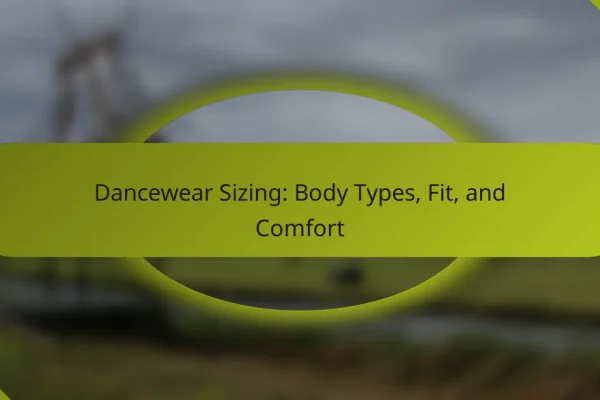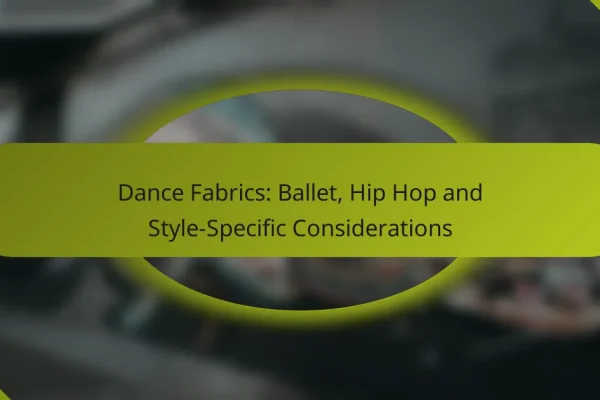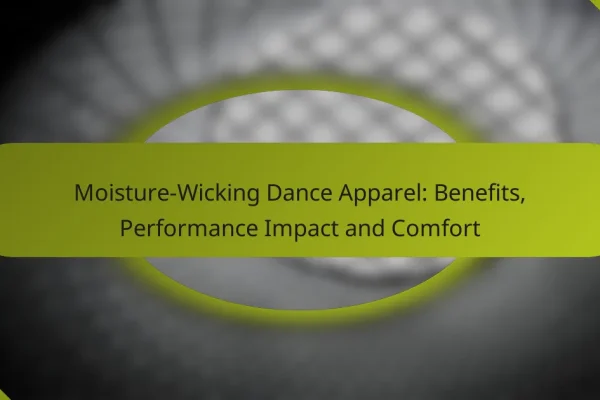
Seasonal Sales: Best Times to Buy Dancewear and Price Strategies
Understanding the best times to buy dancewear can help you save significantly, with seasonal sales…
Dance apparel and accessories play a crucial role in enhancing performance and comfort for dancers of all levels. From ballet leotards to hip hop sneakers, the right clothing provides the necessary support and flexibility for various dance styles. With numerous purchasing options available in major cities and online, finding the perfect gear has never been easier.

Understanding the best times to buy dancewear can help you save significantly, with seasonal sales often providing the best discounts. Key shopping periods include back-to-school sales in August, holiday promotions in December, and spring clearance events in March. Retailers also employ effective pricing strategies, such as dynamic pricing and bundling, to attract customers and manage…

Selecting the right dancewear size is essential for achieving both comfort and functionality, as different body types require tailored considerations. Prioritizing fit and comfort allows dancers to move freely while feeling supported, making it important to choose brands that cater to a variety of shapes and styles. Additionally, the choice of fabric plays a crucial…

Flexibility in dancewear is essential for enhancing a dancer’s performance and comfort. Well-designed garments enable fluid movement and support a wide range of motions, allowing dancers to execute their routines with ease. Prioritizing comfort in dancewear not only improves performance but also allows dancers to concentrate on their technique and expression without distraction. How does…

Understanding fabric quality is crucial for both performance and comfort in athletic wear. High-quality materials not only enhance moisture management and durability but also significantly improve the overall experience during physical activities. For beginners, fabrics like cotton, polyester, and spandex provide an ideal balance of comfort and flexibility, making them perfect for various projects. How…

Maintaining and repairing dance clothing is essential for ensuring longevity and performance. By identifying wear and tear and employing techniques such as stitching and patching, dancers can restore their attire effectively. Additionally, proper washing and drying methods play a crucial role in preserving the fabric’s integrity, allowing dance garments to withstand the demands of practice…

Dancewear with pockets seamlessly blends style and functionality, providing dancers with a practical solution for keeping essentials close during practice and performances. Options such as high-waisted leggings, dance shorts, and leotards are designed to offer convenient storage without compromising comfort or mobility. With several brands specializing in this innovative feature, dancers can enjoy a more…

When it comes to dance, the choice of fabric is crucial for enhancing performance and comfort across different styles. Ballet typically favors elegant materials like silk and cotton, while hip hop dancers benefit from durable and breathable fabrics that allow for dynamic movement. Understanding the specific needs of each dance style can help dancers select…

Moisture-wicking dance apparel is essential for dancers seeking enhanced comfort and performance. By effectively drawing sweat away from the body, these garments help maintain dryness and regulate temperature, allowing for improved focus during practice and performances. With options from renowned brands like Bloch, Capezio, and Gaynor Minden, dancers can find stylish and functional clothing tailored…

Fabric weight plays a crucial role in determining the movement, flexibility, and comfort of clothing, particularly in athletic wear. Lighter fabrics enhance freedom of movement and flexibility, making them ideal for active pursuits, while heavier materials offer more structure and support but may restrict motion. Additionally, the weight of the fabric affects how it feels…

Finding dance apparel discounts online can be straightforward if you know where to look. Popular e-commerce platforms and specialized dancewear websites often offer significant sales and clearance items that can help you save money on quality dance clothing. By comparing prices across multiple retailers and focusing on reputable brands like Bloch, Capezio, and Sansha, you…
For beginners, the best dance apparel options include ballet leotards, jazz pants, and hip hop sneakers. These items provide comfort, flexibility, and support, making them ideal for various dance styles.
Ballet leotards are form-fitting garments that allow for ease of movement and showcase the dancer's lines. They come in various styles, including tank, short sleeve, and long sleeve, typically made from stretchy materials like cotton or spandex.
When selecting a leotard, consider the fit and comfort, as well as the color and style that suit your personal preference. For beginners, a classic black or pink leotard is often recommended, as these colors are widely accepted in ballet classes.
Jazz pants are loose-fitting trousers that provide comfort and freedom of movement, making them suitable for jazz and contemporary dance. They are usually made from lightweight, breathable fabrics and come in various lengths, including full-length and capri styles.
When choosing jazz pants, look for options with an elastic waistband for a secure fit. Beginners should consider darker colors, as they tend to be more forgiving and versatile for different dance classes.
Hip hop sneakers are specially designed footwear that offers support and traction for urban dance styles. They often feature a padded collar and flexible sole, which help prevent injuries while allowing for quick movements.
When selecting hip hop sneakers, prioritize comfort and fit. Look for shoes with good ankle support and a non-slip sole. Popular brands often provide a range of styles and colors, allowing beginners to express their personal style while dancing.
Major cities offer a variety of options for purchasing dance apparel, including online retailers, local stores, and specialty shops. Each option has its advantages, such as convenience, selection, and personalized service.
Online retailers such as Dancewear Corner provide a wide selection of dance apparel, including leotards, tights, and shoes. Shopping online allows you to compare prices easily and access customer reviews, which can help in making informed choices.
When buying online, consider shipping costs and return policies, as these can vary significantly between retailers. Look for sales or discounts to maximize your budget.
New York City boasts several local dance stores that cater to dancers of all styles and levels. Stores like Capezio and Discount Dance Supply offer everything from basic essentials to high-end performance wear.
Visiting a local store allows you to try on apparel for the best fit and receive personalized recommendations from knowledgeable staff. Be prepared to explore different neighborhoods, as some areas may have a concentration of dance shops.
Los Angeles is home to specialty shops that focus on specific dance styles, such as ballet, hip-hop, or contemporary. Stores like The Dance Shop and Dancer's Closet provide tailored selections that cater to the local dance community.
These specialty shops often host events or workshops, making them great places to connect with other dancers. Consider visiting during off-peak hours for a more relaxed shopping experience and better assistance from staff.
Choosing the right dance accessories involves understanding your specific dance style, assessing the quality of materials, and ensuring proper size and fit. These factors will enhance your performance and comfort while dancing.
The type of dance you practice significantly influences the accessories you need. For example, ballet dancers often require tutus, pointe shoes, and leg warmers, while hip-hop dancers might prefer loose-fitting clothing and sneakers designed for street dance.
Each dance style has its own set of requirements, so it's essential to research what is commonly used in your specific discipline. This will help you select accessories that not only look good but also support your movements effectively.
The quality of materials used in dance accessories can impact both performance and durability. Look for items made from breathable fabrics that allow for flexibility and movement, such as cotton blends or moisture-wicking materials.
Additionally, consider the construction of the accessories. For instance, shoes should have sturdy soles and proper arch support, while clothing should be well-stitched to withstand the rigors of dance practice. Investing in high-quality materials can save money in the long run by reducing the need for frequent replacements.
Proper size and fit are crucial for dance accessories to function effectively. Ill-fitting items can hinder your performance and even lead to injuries. Always refer to size charts provided by manufacturers and, if possible, try on accessories before purchasing.
When selecting shoes, ensure there is enough room for your toes to move, but not so much that your foot slides around. For clothing, look for options that allow for a full range of motion without being too loose or restrictive. Taking the time to find the right fit will enhance your comfort and confidence while dancing.
Essential dance accessories enhance performance, provide comfort, and ensure safety during practice and performances. Key items include dance bags, appropriate footwear, and warm-up gear, all of which contribute to a dancer's overall experience.
Dance bags are crucial for organizing and transporting all necessary items for practice or performances. Look for bags with compartments to separate shoes, clothing, and accessories, which helps keep everything tidy and accessible.
When choosing a dance bag, consider size and material. A medium-sized bag is often sufficient for most dancers, while durable materials like nylon or canvas can withstand daily use. Some bags even come with insulated pockets for water bottles or snacks.
Footwear is vital in dance, as it affects performance and injury prevention. Depending on the dance style, options include ballet shoes, jazz shoes, tap shoes, and pointe shoes, each designed for specific movements and surfaces.
When selecting footwear, ensure a proper fit to avoid discomfort. It's advisable to try on shoes while wearing the type of socks you plan to use during practice. Additionally, consider the shoe's flexibility and support, as these factors can significantly impact your dancing experience.
Warm-up gear helps prepare the body for dance by increasing blood flow and flexibility. Common items include leg warmers, fitted tops, and lightweight jackets that can be easily removed as the body warms up.
Choose warm-up gear that allows for a full range of motion and is made from breathable materials. Layering is a good strategy; start with a fitted base layer and add pieces that can be taken off as you heat up. This approach helps maintain muscle warmth and prevents injury during practice or performances.
The latest trends in dance apparel focus on sustainability and performance enhancement. Dancers are increasingly opting for clothing made from eco-friendly materials and high-performance fabrics that support movement while being environmentally conscious.
Eco-friendly materials are gaining popularity in dance apparel, as they reduce environmental impact while providing comfort and style. Fabrics made from organic cotton, bamboo, and recycled polyester are common choices, offering breathability and softness.
When selecting eco-friendly dancewear, look for certifications such as Global Organic Textile Standard (GOTS) or OEKO-TEX, which ensure that the materials meet environmental and safety standards. Brands are now incorporating these materials into their collections, making it easier for dancers to make sustainable choices.
High-performance fabrics are designed to enhance a dancer's movement and comfort. These materials often include moisture-wicking properties, stretchability, and durability, allowing for a full range of motion during practice and performances.
Common high-performance fabrics include nylon blends, spandex, and advanced synthetic materials that provide support and flexibility. When choosing dance apparel, consider options that feature flat seams to minimize chafing and ensure a comfortable fit while dancing.